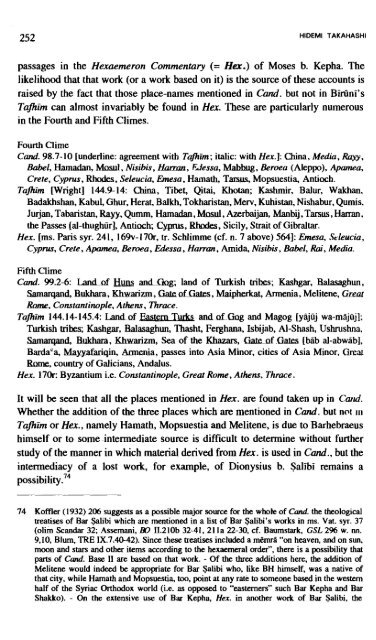doc.pdf
doc.pdf
doc.pdf
You also want an ePaper? Increase the reach of your titles
YUMPU automatically turns print PDFs into web optimized ePapers that Google loves.
passages in the Hexaemeron Commentary (= Her.) of Moses b. Kepha. The<br />
likelihood that that work (or a work based on it) is the source of these accounts is<br />
raised by the fact that those place-names mentioned in Cand. but not in Biriini's<br />
Tafiim can almost invariably be found in Hex. These are particularly numerous<br />
in the Fourth and Fifth Climes.<br />
Fourth Clime<br />
Cand. 98.7-10 [underline: agreement with Tajhim; italic: with Hex.]: China, Media, &qy,<br />
Babel, Hamadan, MQSU~, Nisibis, Haom, Fiessa, Mahhug , Beroea (Aleppo), Apamea,<br />
Crete, Cyprus, Rhedes , Seleucia, Emesa , Harnath, 'Emus, Mopsuestia, Antid.<br />
Tajhim Wright] 144.9-14: China, Tibet, Qitai, Khotan; Kashmir, Balur, Wakhan.<br />
Badakhshan, Kabul, Ghur, Herat, Balkh, Tokharistan, Men, Kuhistan, Nishabur, Qumis.<br />
Jurjan, Tabaristan, my, Qurnrn, HamaBan, Masul, Azerbaijan, Manbij,Tarsus, Harm.<br />
the Passes [al-thughiir], Antinch; Qps, Bhad%s, Sicily, Strait of Gibraltar.<br />
Hex. [ms. Paris syr. 24 1, 169v- 170r, tr. Schlimme (cf. n. 7 above) 5641: Emesa, Seleucia,<br />
Cyprus, Crete, Apamea, Beroea , Edessa , Ham, Amida, Nisibis , Babel, Rai, Media.<br />
Fifth Clime<br />
Cand. 99.2-6: Lamid HUB an-; land of Turkish trihes; I(ashgar, Balasaghun,<br />
Samarqand, Bukhara, KhWzm, fiakaf(iatp;s, MaQdwbt, Armenia, Melitene, Guw<br />
lhme, Constantinople, Athens, Thrace.<br />
Tajhim 144.14- 145.4: Landnf ,Eastern and nf Liag and Magog [yajiij wa-~~JuJ];<br />
Tvrkish trib, Kashgar, Balasaghun, Thasht, Ferghana, Isbijab, Al-Shash, Ushrushna.<br />
Samarqand, Bukhata, Khwarizm, Sea of the Khazars, Waf Gates [bab al-abwab],<br />
Barda'a, ~ y M a , passes ~ into Asia , Minor, cities of Asia Minor, Grear<br />
Bnme, country of Galicians, Andalus.<br />
Hex. 17k Byzantium i.e. Constantinople, Great Rome, Athens. Thrace .<br />
It will be seen that all the places mentioned in Hex. are found taken up in Cud.<br />
Whether the addition of the three places which are mentioned in Cand. but not 111<br />
Tafiim or Hex., namely Hamath, Mopsuestia and Melitene, is due to Barhebraeus<br />
himself or to some-intermediate source is difficult to determine without further<br />
study of the manner in which material derived from Hex. is used in Cand., but the<br />
intermediacy of a lost work, for example, of Dionysius b. Salibi remains a<br />
possibility.74<br />
74 Koffler (1932) 206 suggests as a possible major source for the whote of Cund. the theological<br />
treatises of Bar Salibi which are mentioned in a list of Bar Salibi's works in ms. Vat. syr. 37<br />
(ohm Scandar 32; Assemani, BO II.210b 32-41, 21 la 22-30, cf. Baumstark, GSL 2% w. M.<br />
9.10, Blum, TRE IX.7.#42). Since these treatises included a me& "on heaven, and on sun.<br />
moon and stars and other items according to the hexaemeral order", there is a possibility that<br />
parts of Cd. Base I1 are based on that work. - Of the three additions here, the addition of<br />
Melitene would indeed be appropriate for Bar Salibi who, like BH himself, was a native of<br />
that city, while Harnath and Mopsuestia, too, point at any rate to someone based in the western<br />
half of the Syriac Orthodox world (i.e. as opposed to "easterners" such Bar Kepha and Bar<br />
Shakko). - On the extensive use of Bar Kepha. Hex. in another work of Bar Salibi, the
















